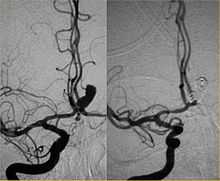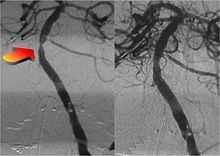Neurointerventional surgery
Endovascular surgical neuroradiology (ESN), originally known as interventional neuroradiology or neurointerventional radiology, is an Accreditation Council for Graduate Medical Education (ACGME) accredited medical subspecialty specializing in minimally invasive image-based technologies and procedures used in diagnosis and treatment of diseases of the head, neck, and spine. While ESN programs can be ACGME accredited, fewer than five programs in the U.S. are accredited. The number of physicians in the United States with an active interest and special competency in this field is estimated to be around 600.
History
The technique that constitutes the basis for angiographic neurointerventions, and thus, interventional neuroradiology, was first developed in 1927 by the Portuguese physician Egas Moniz at the University of Lisbon to provide contrasted x-ray angiography in order to diagnose several kinds of nervous diseases, such as tumors, coronary heart disease and arteriovenous malformations. He is usually recognized as one of the pioneers in this field. Moniz performed the first cerebral angiogram in Lisbon in 1927.
Traditionally spearheaded by neuroradiologists who invented and refined these techniques, the subspecialty has more recently attracted the attention of neurosurgeons and, to a lesser extent, neurologists. These changes in practitioner demographics have been recognized by formally changing the name of the specialty from interventional neuroradiology (INR) to endovascular surgical neuroradiology (ESN). In addition, the governing body of this specialty, which used to be known as the American Society of Interventional & Therapeutic Neuroradiology (ASITN), changed its name to the Society of Neurointerventional Surgery (SNIS). Practitioners from each specialty are generally regarded to bring a distinct set of skills to the practice of ESN; for instance, in general, interventional neuroradiologists are regarded to bring broad angiographic and endovascular experience from non-neurological domains as well as special expertise in image interpretation that underlies image-guided specialties such as ESN, whereas in general, neurosurgeons are regarded to bring a special understanding of and ability to implement conventional surgical alternatives to endovascular treatments for conditions such as intracranial aneurysms and arteriovenous malformations that can be treated by either (or both) approaches.
Training
Neurointerventional fellowships are variable in length, but typically last from one to three years with a focus on the integration of clinical management and performance of endovascular and minimally-invasive surgeries of the conditions/diseases listed below. Many fellowships require a second year of training that allows participants to further hone their technical skills and assert a greater degree of influence in clinical management of patients with diseases of interest.
Preparatory requirements for a fellowship in INR/ESN vary by choice of residency.
The most traditional and well-established route to ESN training involves successful completion of a medical/surgical internship (1 year) and radiology residency (4 years), the latter of which involves exposure and training not just to ESN techniques but also related techniques in interventional radiology performed in other parts of the body. Following residency, candidates must complete a one- to two-year fellowship in diagnostic neuroradiology before initiating additional fellowship training in ESN lasting one to two years. The total length of this training pathway is thus 7-9 years, plus at least four years in medical school. Graduates of this pathway are typically referred to as interventional neuroradiologists. A small number of radiologists complete training in both interventional radiology and interventional neuroradiology.
Candidates from neurosurgery must successfully complete a six- or seven-year neurosurgery residency, with most programs now mandating at least some exposure to interventional neuroradiology techniques during this time in addition to ongoing procedural experience with traditional surgical techniques. Following residency, neurosurgeons must complete a one- to two-year fellowship in ESN, though some have opted for more limited and somewhat controversial 6-month fellowships. The total length of this training pathway is thus 7-9 years, plus at least four years in medical school. Graduates of this pathway are typically referred to as endovascular neurosurgeons.
Candidates from neurology must successfully complete a clinical internship (1 year) and neurology residency (3 years). In most programs, procedural experience is limited relative to colleagues in the more traditional pathways of radiology or neurosurgery. As such, neurologists must complete additional fellowship training in neurovascular diseases/vascular neurology, stroke neurology, or neurocritical care (1 year) followed by fellowship training in ESN lasting one to two years. The total length of this training pathway is thus 6-7 years, plus at least four years in medical school. Graduates of this pathway are typically referred to as interventional neurologists.
Diseases and conditions


The following is a list of diseases and conditions typically treated by neurointerventionalists.
- Cerebral aneurysm
- Brain arteriovenous malformation (AVM)
- Carotid-cavernous fistula (CCF)
- Dural arteriovenous fistula
- Extracranial (brachiocephalic) atherosclerosis
- Extracranial (head and neck) and paraspinal vascular malformations
- Head and neck tumors
- Intracranial atherosclerosis
- Juvenile nasopharyngeal tumor
- Meningiomas
- Nosebleeds
- Paragangliomas
- Stroke
- Spinal vascular malformations
- Traumatic vascular lesions
- Vasospasm
- Vertebral body tumors
- Vertebral body compression fractures